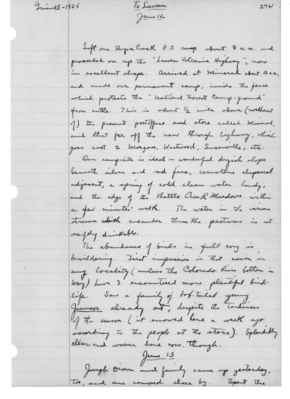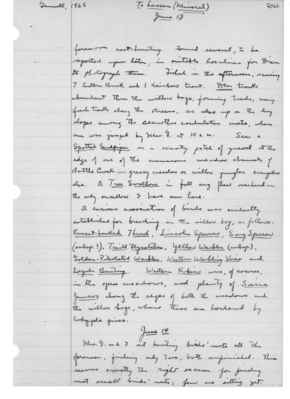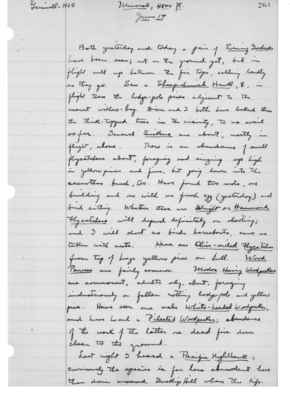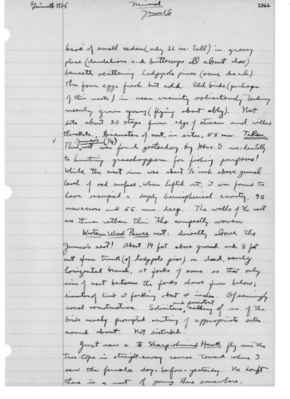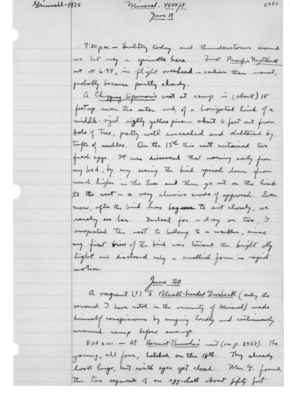Pages That Mention 1925-06-13
1925: Joseph Grinnell's field notes
S2 Page 5
Collector: Grinnell - 1925 Location: Lassen Section Date: June 12-13, 1925 Page Number: 2461
Left our Payne Creek P.O. camp about 8 a.m. and proceeded on up the "Lassen Volcanic Highway", now in excellent shape. Arrived at Mineral about 10 a.m., and made our permanent camp, inside the fence which protects the "National Forest Camp-ground" from cattle. This is about 1/2 mile above (northeast of) the present postoffice and store called Mineral, and that far off the new thorough highway, which goes east to Morgan, Westwood, Susanville, etc. Our campsite is ideal - wonderful dryish slope beneath silver and red firs, ceanothus chaparral adjacent, a spring of cold clean water handy, and the edge of the Battle Creek Meadows within a few minutes' walk. The water in the various streams which meander thru the pastures is not safely drinkable. The abundance of birds in full song is bewildering. First impression is that never in any locality (unless the Colorado River bottom in May) have I encountered more plentiful bird life. Saw a family of bob-tailed young Juncos already out, despite the tardiness of the season (it snowed here a week ago according to the people at the store). Splendidly clean and warm here now, though. June 13, 1925. Joseph Dixon and family came up yesterday, too, and are camped close by. Spent the
S2 Page 6
Collector: Grinnell - 1925 Location: Lassen Section (Mineral) Date: June 13-14, 1925 Page Number: 2462
forenoon nest-hunting. Found several, to be reported upon later, in suitable locations for Dixon to photograph them. Fished in the afternoon, securing 7 Eastern Brook and 1 Rainbow Trout. Deer tracks abundant thru the willow bogs, forming trails; many fresh tracks along the streams, as also up on the dry slopes among the Ceanothus cordulatus mats, where one was jumped by Mrs. G at 10 a.m. Saw a Spotted Sandpiper on a scanty patch of gravel at the edge of one of the numerous meadow channels of Battle Creek - grassy meadows on willow jungles everywhere else. A Tree Swallow in full song flew overhead - the only swallow I have seen here. A curious association of birds was evidently established for birding in the willow bog, as follows: Russet-backed Thrush, Lincoln Sparrow, Song Sparrow (subsp.?), Traill Flycatcher, Yellow Warbler (subsp.), Golden-Pileolated Warbler, Western Warbling Vireo and Lazuli Bunting. Western Robins were, of course, in the open meadows, and plenty of Sierra Juncos along the edges of both the meadows and the willow bogs, where these are bordered by lodgepole pines. June 14 Mrs. G. and I out hunting birds' nests all the forenoon, finding only two, both unfinished. This seems exactly the right season for finding most small birds' nests; few are sitting yet.
S2 Page 7
Collector: Grinnell - 1925 Location: Lassen Section (Mineral) Date: June 14, 1925 Page Number: 2463
Both yesterday and today a pair of Evening Grosbeaks have been seen; not on the ground yet, but in flight well up between the fir tops, calling loudly as they go. Saw a Sharp-shinned Hawk, female, in flight thru the lodge-pole pines adjacent to the nearest willow-bog. Dixon and I both have looked thru the thick-topped trees in the vicinity, to no avail so far. Several Siskins are about, mostly in flight, above. There is an abundance of small flycatchers about, foraging and singing up high in yellow pines and firs, but going down into the ceanothus bush, too. Have found two nests, one building and one with one fresh egg (yesterday) and bird sitting. Whether these are Wright or Hammond Flycatchers will depend definitely on shooting; and I will shoot no birds hereabouts, save any (?) taken with nests. Hear one Olive-sided Flycatcher from top of huge yellow pine on hill. Wood Pewees are fairly common. Modoc Hairy Woodpeckers are commonest, adults only, about, foraging industriously on fallen rotting lodge-pole and yellow pine. Have seen one male White-headed Woodpecker, and have heard a Pileated Woodpecker; abundance of the work of the latter on dead firs down clean to the ground. Last night I heard a Pacific Nighthawk; curiously this species is far less abundant here than down around Inskip Hill where the life-
S2 Page 10
Collector: Grinnell - 1925 Location: Lassen Section (Mineral) Date: June 15, 1925 Page Number: 2466
base of small cedar (only 32 in. tall) in grassy place (dandelions and buttercups all about also) beneath scattering lodgepole pines (some dead). The four eggs fresh but cold. Old birds (perhaps of this nests) in near vicinity solicitously tending nearly grown young (flying about ably). Nest sits about 20 steps from edge of stream and willow thickets. Diameter of nest, in situ, 55 mm. Taken. This Junco's (1/4) nest was found yesterday by Mrs. G incidentally to hunting grasshoppers for fishing purposes! While the nest rim was about 1/2 inch above general level of sod surface, when lifted out, it was found to have occupied a deeply hemispherical cavity. 90 mm. across and 55 mm. deep. The walls of the nest are thus rather thin this compactly woven. Western Wood Pewee nest: directly above the Junco's nest! About 14 feet above ground and 7 feet out from trunk (of lodgepole pine) on dead, nearly horizontal branch, at forks of same so that only rim of nest between the forks shows from below; diameter of limb at forking about 4 inches. Of seemingly usual construction. Solicitous and persistent calling of one of the birds nearly prompted scrutiny of appropriate sites round about. Not disturbed. Just saw a male Sharp-shinned Hawk fly over the tree-tops in straight-away course toward where I saw the female day-before-yesterday. No doubt there is a nest of young there somewhere.
S2 Page 27
Collector: Grinnell-1925 Location: Mineral, 4800 ft. Date: June 19 Page Number: 2482
7:30 p.m. - Sultry today and thunderstorms around us but only a sprinkle here. First Pacific Nighthawk out at 6:45, in flight overheard - earlier than usual, probably because partly cloudy.
A Chipping Sparrow's nest at camp is (about) 18 feet up near the outer end of a horizontal limb of a middle-sized sickly yellow pine - about 6 feet out from bole of tree, pretty well concealed and sheltered by tufts of needles. On the 13th this nest contained two fresh eggs. It was discovered that morning early from my bed, by my seeing the bird spiral down from much higher in the tree and then go out on the limb to the nest - a very elusive mode of approach. Even now, after the bird has begun to sit closely, we rarely see her. Indeed for a day or two, I suspected the nest to belong to a warbler, since my first view of the bird was toward the bright sky light and disclosed only a smallish form in rapid motion.
June 20. A vagrant (?) [male symbol] Black-headed Grosbeak (only the second I have noted in the vicinity of Mineral) made himself conspicuous by singing loudly and continuously around camp before sun-up.
8:00 a.m. - At Hermit Thrushes' nest (see p. 2468). The young, all four, hatched on the 18th. They already look huge, but with eyes yet closed. Mrs. G. found the two segments of an eggshell about fifty feet
